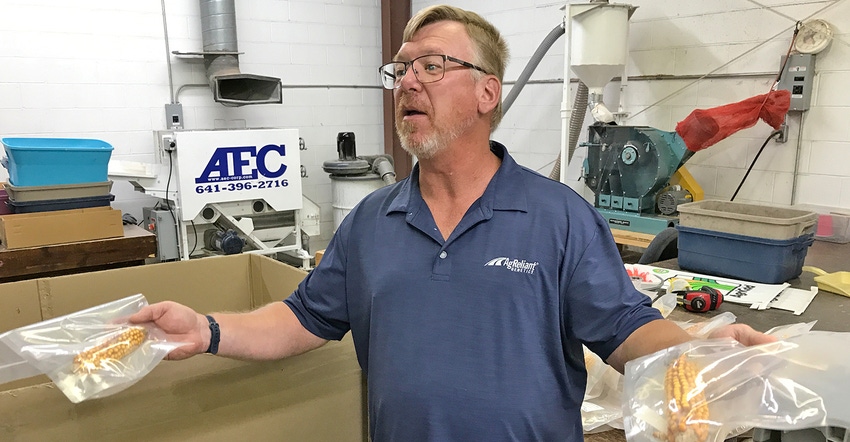October 19, 2018

Corn breeding is as much art as science even in these days of molecular markers and DNA testing. Just ask Tim Cupka, a corn breeder with AgReliant Genetics. The company, formed in 2000, is a joint venture between Germany’s KWS and France’s Limagrain, and markets AgriGold, LG Seeds and Pride Seeds for corn, soybean, sorghum and alfalfa. Farm Progress got a chance to visit with Cupka in his AgReliant’s Lebanon, Ind., facility recently to talk about corn breeding.
“We’re looking at our parent inbreds,” he said. “I was just in Ohio and got a good look at our plots. I know what I’ll probably be keeping out of those.” He was noting the lines that had lodged after some winds, and those that were still standing tall. But that’s part of the “art” of corn breeding — even those that went down may have desirable traits for the future.
Cupka manages one of AgReliant’s 12 breeding stations. He works out of the company’s Lebanon facility and covers breeding in the Eastern Corn Belt. He can brag that he’s the first AgReliant employee, coming on board just after the joint venture was formed. And Cupka is a veteran corn breeder who keeps his eye on the field.
“Many breeders are getting caught up in markers and building great hybrids on paper,” he said. “But when you plant them, they grow to 11 feet tall — and they’re not realistic.” Cupka emphasizes his focus on field breeding, and he’s tough on his inbred program.
“We’re 100% double-haploid for inbreds,” Cupka said, noting that this tool was first found in the 1950s but has really come on strong since the late 1990s to build new parent inbreds. With that approach, it’s possible to breed new inbred lines in a fraction of the time compared to conventional approaches.
But once the parent inbreds are ready, the next step is to field-test them and make sure what Cupka and other company breeders have bred will perform. The Lebanon greenhouse is also a facility designed to help speed breeding and trait introgression for new crops. “We can produce four crops in a year in the greenhouse,” Cupka noted.
Not without markers
While Cupka talks about the importance of field information for breeding, that doesn’t mean the company isn’t using the latest tools to make sure key traits are included in crops. AgReliant has an automated lab for DNA testing to determine the presence of key markers.
Jialiang Chen, a scientist in the marker lab in Lebanon, explained that the purpose of the lab is to make sure the desired traits identified have made it into parent inbreds. Traits are also evaluated not only for their presence, but also for their location in the plant — in effect, making sure that the inbred will perform in making top-producing hybrids.
The company system can use single-nucleotide polymorphisms, or SNPs, to determine if out of millions of different markers, the desired traits ended up on the inbred. “If you have two corn plants with the same phenotype, we can use this to screen for desired traits,” he said.
And the system is now automated, so a much higher number of samples can be pushed through the system in a season. Added Cupka: “This allows us to test many more inbreds faster, which is important.”
That marker tech can also make sure that a key trait — such as herbicide or insect resistance — has been properly inserted into the inbred. That’s important as the company works to bring more traited hybrids to market.
“When we insert a new trait, a lot of other stuff comes along,” Cupka said. “We want to work to get the germplasm to the customer as quickly as possible. This helps us do it.”
After a walk-through of the facility, we ended up in a room with inbred sample ears from the early part of the 2018 harvest. Cupka picked up a couple, noting the lack of kernels or other deformities in the final plant. Those poor-looking ears go in a dumpster. But good-looking inbred ears get sorted into garbage cans.
“There’s a story of a great parent inbred that was pulled out of a garbage can,” Cupka recalled. “I think using garbage cans might bring us luck.”
The world of corn breeding continues to change. From double-haploid inbred breeding to genetic marker testing, there are plenty of new tools for breeders. “But it still has to perform in the field,” Cupka concluded.
About the Author(s)
You May Also Like






